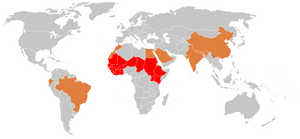Meningitis facts for kids
Meningitis is a serious infection that affects the protective layers around your brain and spinal cord. These layers are called the meninges. Their job is to keep your central nervous system safe.
Most often, tiny living things called microorganisms cause this infection. These can be viruses, bacteria, fungi, or even parasites. Viruses are the most common cause of meningitis, followed by bacteria. Meningitis can be very dangerous and can affect people of all ages.
Some types of meningitis can spread easily from person to person. Because of this, in some countries, doctors must report cases of meningitis to health authorities. This helps prevent more people from getting sick.
Contents
What are the Signs of Meningitis?
If someone has meningitis, they might show several signs. It's important to know these so you can get help quickly.
- A high fever, sometimes with chills.
- A very bad headache.
- Feeling sick to your stomach (nausea) and vomiting.
- Feeling very sleepy or confused.
- Having a stiff neck (though not everyone with meningitis has this).
- Twitching or seizures.
- Sore throat.
- Acting confused or seeing things that aren't there (especially in children).
Types of Meningitis
There are two main types of meningitis: bacterial and viral. Knowing the difference is important because they are treated differently.
Bacterial Meningitis
This type is caused by bacteria. It is very serious and can be life-threatening if not treated quickly. Most people with bacterial meningitis need urgent medical care, often in a hospital. Doctors usually treat it with strong medicines called antibiotics.
Viral Meningitis
This type is caused by viruses. It is usually less serious than bacterial meningitis. Most people with viral meningitis get better on their own without special treatment. Sometimes, if a specific virus like the herpes virus causes it, doctors might use antiviral medicines.
Related Topics
- Encephalitis: This is when the brain itself becomes swollen or inflamed.
Images for kids
See also
 In Spanish: Meningitis para niños
In Spanish: Meningitis para niños







